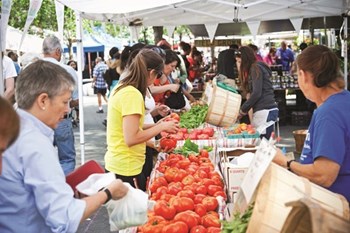
For most, living in a co-op or condo association implies at least some level of interest in being part of a larger community. That interest is usually limited to the condo or co-op community itself – but what about the greater community around your building? Do co-ops and condos integrate themselves into the greater communities around them? Do they extend themselves outward to build quality of life in their neighborhoods, or are they more like islands unto themselves? The Cooperator took a look around Manhattan’s Washington Heights to see how those invested in their buildings also invest in their neighborhoods.
The Meadow on Overlook
Judith Graeff and Doug Proops have lived at 736 West 186th Street in Washington Heights for approximately 15 years. Their 54-unit co-op building, located on the corner of west 186th Street and Overlook Terrace, faces the sheer granite outcropping that rises up to Fort Washington Avenue above. Atop that outcropping sit many apartment buildings, as well as the Manhattan Early Childhood Center, operated by Birch Family Services. The rear portion of the lot on which the school building rests is a steeply sloped, undeveloped portion of land fenced in at the bottom along Overlook Terrace. The drop is so sheer, the vacant portion of the lot is barely visible from the school’s playground at the apex of the hill.
Over the years, the lower portion of the fenced lot, which is visible from half the apartments at 736, became overgrown and garbage-strewn. In 2013, Graeff was on the co-op’s board. She received a note from another shareholder in the building noting the condition of the lot and asking if there was anything the building could do about its unsightliness. “Officially,” explains Graeff, “we couldn’t do anything, but we did write a letter to the director of the school, and the school was very responsive. They wanted to do something to improve the situation. We offered to help.”
Initially, the school appealed to local nurseries for proposals to improve the overgrown lot. One offered a $3 million plan. Clearly, that was out of reach. A more modest plan to plant six dogwood trees was enacted. Four of those trees survived and continue to grow, but that approach didn’t address the problem sufficiently. Graeff and Proops, both of whom had interest in botany and horticulture, attempted seeding the lot with wildflowers to begin rehabilitating the space. They literally pitched seed bags over the fence – and lo and behold, the seeds took, eventually carpeting that section of the trashy lot with free-growing wildflowers. Life finds a way.
Graeff and Proops didn’t want to create a formal garden, though. Their approach was to create a less labor-intensive, more natural environment. “Our botanical approach to rehabilitate the yard is to create a ‘meadow’ by introducing plants, flowers, ferns, and shrubs that grow wild in the Northeast and will spread on their own,” says Graeff, “doing battle with the weeds, slowing erosion of the slope, and eventually not needing any upkeep. As we clear a section of weeds, we are introducing wildflowers of the area; black-eyed Susans, cone flowers, shasta daisies, tiger lilies, ferns, lily of the valley, and asters. These plants serve as pollinators and food sources for bees, butterflies and birds. It will take several growing seasons to see what plants thrive and spread, and compete successfully with the weeds. This approach is different from a manicured garden which needs constant tending to retard weeds, enrich the soil, kill bugs, give extra water, add mulch, etc. The boulders and severe pitch of the property make that kind of gardening unrealistic.”
Graeff goes on to say that “Currently, when frost kills the plants in the fall, the slope remains barren all winter. The school organized with a nursery to plant evergreen trees along the concrete fence, so eventually they will cover much of that area. This fall, 2019, we are planting holly and coastal azalea shrubs that don’t lose their leaves in the winter along the bit of apartment wall facing the property that has invited graffiti.”
The project also offers an educational opportunity. “We were invited to a pre-K class, and integrated making a meadow behind their school with their April emphasis on plants and water,” Graeff says. “We read the book The Curious Garden by Peter Brown, about a boy who encourages plants in his urban neighborhood to grow, thus transforming urban ugliness into a green and colorful place that the neighbors are proud of. In addition, we helped the students make ‘seed rockets’, which are dirt and seeds spooned on to toilet paper and tied with a string, which they threw over the chain link fence from the playground in mid-April. Now, from their playground, they will see wildflowers growing in the meadow they helped to create.”
The project has also gotten other shareholders from 736 and the adjacent co-op at 45 Overlook Terrace, as well as other neighbors, involved in the project. They weed, dig in the dirt, and contribute funds. One neighbor working in the garden even became reacquainted with her elementary school teacher, who happened to still be living in the neighborhood. The project has encouraged outreach to other co-ops and rental management companies to clean up their properties along Overlook as well.
A Neighborhood Facelift
Dana Hockenbury has lived at Woodrow Court at 565 West 169th Street, also in Washington Heights, for nearly two decades. She founded the Washington Heights Gardening Club (WHGC) 19 years ago with the intention of beautifying the neighborhood.
The project started in the immediate area around Woodrow Court with the installation of wrought iron fencing around the tree pits that dotted the sidewalks near the building, and the small park immediately to the west of the property. To raise the funds to pay for the fencing around the tree pits, the WHGC collected gently used clothing and other items which they sold ‘flea-market’ style in the little park. The co-op provided a space in the building to store the items as they were collected, as well as gardening equipment.
In addition to providing the fencing, the club plants the tree pits with annuals in the spring and bulbs in the fall, which provide a welcome dash of color when they bloom. Over 19 years, the club has extended their beautification efforts up into the 170s along both Broadway and St. Nicholas Avenues, despite the cost of the fencing for the tree beds rising over the years. “When we started the cost was about $550 per bed, now it runs about $850 per bed,” Hockenbury says.
The project now reaches into the greater community as well. “We work in conjunction with Uptown Dreams, a boys and girls organization run by Coach Dave Cranshaw,” Hockenbury continues. “The project gives young people a chance to both work within their community and to experience gardening in an urban environment.” Columbia Presbyterian Hospital, a major presence in the area, has also responded to the WHGC’s work, adopting the same style and design for tree bed fencing and planting in their part of the neighborhood, to the south of Hockenbury’s co-op. The hospital’s efforts are centered south of 168th Street, while the club focuses north of 168th Street.
Community involvement on the part of shareholders and co-op buildings is clearly alive and well in Washington Heights, and the benefits are clear. The co-op community, the individual shareholders, and the neighborhood benefit – not just by having more greenery and flowers to break up the monotony of concrete, but by getting to know their neighbors, and knowing that those neighbors care about the look and feel of the area, and the people who call it home. One can only hope that not only will these types of projects continue, but that the idea of community involvement in the greater community will increase, that these projects will be an example to others to dig right into what their larger community needs.
A J Sidransky is a staff writer/reporter for The Cooperator, and a published novelist.









Comments
Leave a Comment